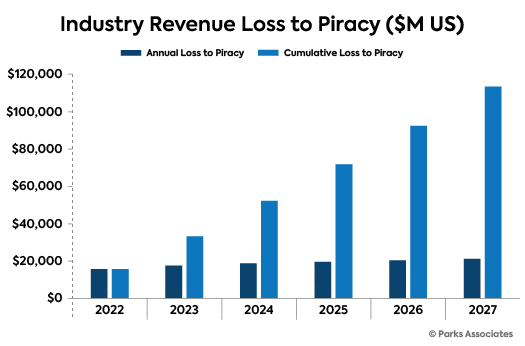By the end of 2027, video streaming companies serving U.S. consumers will incur a cumulative loss of $113 billion due to piracy, according to Parks Associates.
The “Streaming Piracy Market & Ecosystem Strategies” report predicts that piracy rates for companies in the U.S. that stream film and television programming will rise from a rate of 22% in 2022 to 24.5% in 2027. The firm also said that fraudulent advertising delivered online to media and entertainment consumers may be more than $700 million in 2027.
Parks Associates said that visits to pirate hosting site increased by 31% in 2020 and that the industry is seeking new policies to confront the problem.
Sara Lee, a Parks research analyst noted in the press release that password sharing has risen 48% since 2019.
One approach to discourage this practice is to restrict the number of users who can simultaneously stream a service, though Parks Associates says that such policies may impact the user experience.
The researchers called out two approaches aimed at addressing this. Netflix is introducing a feature that authorizes streamers to share passwords for an extra fee. And Adobe’s Prime Account IQ helps providers identify when passwords are being shared.
Video Streaming Piracy
“While there is some optimism that emerging countermeasures and best practices may see piracy begin to plateau by 2027, there is no consensus among stakeholders as to when it may begin to decline,” Steve Hawley, Contributing Analyst for Parks Associates and Managing Director of the Piracy Monitor industry newsletter and consultancy, said in a press release.

Piracy, of course, is not a new problem. Parks Associates said in 2019 that over the top and pay-TV companies were set to lose about $9.1 billion in revenue to piracy and account sharing that year. By 2024, the firm said at the time, losses would reach $12.5 billion.



